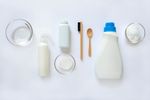Ambiance shouldn't come with air pollution. Use these expert tips to make sure your home has a healthy glow.
Every home style vibe — from minimalist modern to rustic country — has one decorative element in common: candles. And they aren’t just pretty accents; candles can create a relaxing atmosphere that transforms any room into a sanctuary.
They can also harm your health. The candle industry is largely unregulated, so there aren’t strict safety guidelines candlemakers need to adhere to, especially when it comes to ingredients. Because of that, most candles on the market are scented with synthetic fragrances that can contain dangerous chemical ingredients. That said, you can find “clean,” non-toxic candles made with natural, unadulterated ingredients that are safer for your health — if you know what to look for.
How to Pick a Non-Toxic Candle
Below, experts share three tips to keep in mind when shopping for a safer option:
1. Look for Natural Wax
Many traditional synthetic candles are made of wax that is chock-full of chemicals. Two of the most common ones found are benzene, which has been found to increase the risk of certain cancers, and toluene, which can irritate your eyes, nose and throat and lead to headaches, dizziness and other negative effects without proper ventilation, according to the Cleveland Clinic.
But that's not all: Hormone-disrupting phthalates and paraffin, a byproduct of petroleum, are also other potentially harmful ingredients often found in synthetic candles, adds Sophia Ruan Gushée, author and host of The Practical Nontoxic Lifestyle podcast.
RELATED: All About Endocrine Disruptors
So what type of wax should you look for when shopping for candles? Environmental toxin expert Tonya Harris recommends soy wax, beeswax or coconut wax. When it comes to non-toxic candles, make sure they're fully (read: 100 percent) made from these natural waxes, as some companies blend in paraffin wax to make production more cost effective, warns Harris.
2. Choose a Cotton Wick
Wicks may seem insignificant, but they can be a potential health hazard as well. "Wicks can contain toxic chemicals and heavy metals, including lead," says Gushée. One study found that burning traditional candles with lead wicks can result in indoor air concentration of lead above Environmental Protection Agency-recommended thresholds. For that reason, Gushée and Harris both recommend buying candles with 100-percent cotton wicks.
Some good news? The US Consumer Product Safety Commission banned the manufacture and sale of lead-cored wicks (and candles containing them) back in 2003. But that's not necessarily the case in other countries. And, according to University of Central Florida Health, a small number of candles imported to the U.S. contain lead in the wicks. So, your best bet is to heed the pros advice and make sure the product you're buying has a wick that's truly 100-percent cotton.
3. Prioritize Pure Scents
Any time you see the word "fragrance" on a candle, be wary — even if it's marketed as a clean candle. Why? "Fragrance can contain hundreds of chemicals," says Gushée. Companies are not obligated to disclose all the ingredients that are in their fragrances, according to the US Food and Drug Administration. (Nuts, right?)
Some people can have an allergic reaction (headaches, rashes, difficulty breathing) to artificial scents in candles, says Harris. “Those who don’t enjoy the fragrance from synthetic candles are probably sensitive to those chemicals," says Gushée, who advises avoiding added coloring dyes for this same reason.
RELATED: How to Make Your Home a Sanctuary
However, even if you aren't sensitive to the ingredients in artificial candles, the byproducts produced by burning them still end up in the air. According to the Cleveland Clinic, burning scented candles can release volatile organic compounds (VOCs), and certain VOCs, like formaldehyde, could increase your risk of cancer. However, more research is needed to truly determine the health impacts of these compounds released by burning candles.
The safest option is an unscented candle, but if you crave an aroma, look for candles that are scented with natural ingredients, such as 100-percent pure essential oils.
Pro tip: Naturally scented candles may not smell quite as strong as traditional synthetic candles, but there are simple ways to amp up their aroma. Try lighting them in smaller rooms to contain the scent and place them away from air vents and open windows.
Our Favorite Pick:
Lighting a candle can be a powerful and meaningful part of celebration, meditation, self-care rituals, religious ceremonies and more. But it pays to do your research before hitting "Add to Cart." Look for companies that are transparent about the ingredients they use (especially fragrances), even if the FDA doesn’t hold them to it.
Our Sun Salutation Candle ticks all the safety boxes when it comes to non-toxic candles — and has a divine mellow citrus scent.
- 100-percent plant-based wax (coconut and sustainably harvested palm)
- Lead-free cotton wick
- Fragranced with pure essential oils and flower extracts (neroli, bergamot, sweet orange, lemon)
- Free of parabens, phthalates, petroleum and added colors
- Bonus: You can repurpose the ceramic vessel as a planter, pen holder and more.




